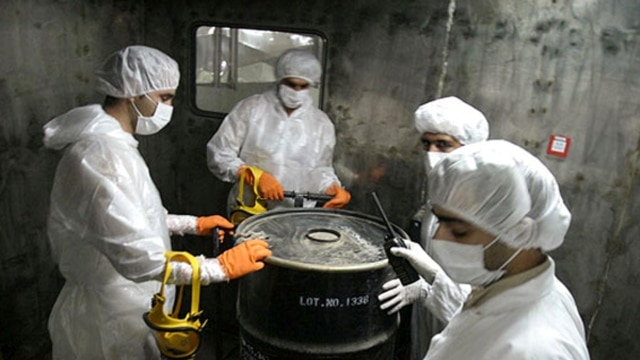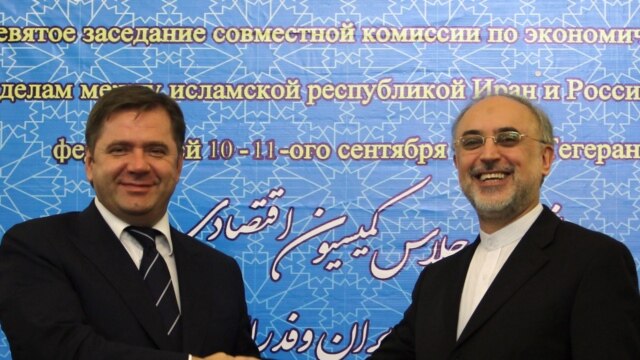The UN nuclear watchdog's latest report on Iran's activities does not say that Iran has a nuclear weapons program.
But it comes very close to doing so.
The evidence presented in the International Atomic Energy Agency's (IAEA) leaked report describes activities undertaken by Iran that normally would only be done for the purpose of developing a nuclear warhead.
Those activities include:-- the testing of high explosives, possibly in association with nuclear materials, at a special facility built at a military complex;
The IAEA says "the application of such studies to anything other than a nuclear explosive is unclear to the agency."
The agency also says that prior to 2003 those activities "took place under a structured program" and that there are "indications that some activities relevant to the development of a nuclear explosive device continued after 2003 and that some may still be ongoing."
Nuclear experts say these conclusions go well beyond the IAEA's earlier reports about Iran, which have largely focused on evidence on Iran's interest in dual-use technology that can potentially be applied to a nuclear weapons program.
"That the IAEA produces 10 to 12 pages with this type of detailed information on a possible covert military program -- that's a first," says Daniel Nord, deputy director of the Stockholm International Peace Research Institute (SIPRI) in Sweden.
He notes that it is hard for nuclear experts to see studies on high-explosives testing as anything other than for a weapon because there is no need for such testing in connection with a peaceful nuclear energy program. Studies with detonators and computer modeling of nuclear explosions are equally difficult to view as part of an energy program.
On-Again, Off-Again?
It is the possibility that some of these activities may still be ongoing that will create the strongest new worries about Iran's nuclear intentions.
The IAEA's suspicions run counter to an earlier intelligence assessment by the United States in 2007 that Tehran had stopped its nuclear program. That National Intelligence Estimate assessed "with high confidence" that Iran had a nuclear-weapons program until 2003 but that it was discovered and Iran stopped it.
Nord says that 2007 assessment, which was controversial at the time, now looks increasingly shaky.
"The [new IAEA] report mentions that [activities] seem to take a halt in 2003 and then some of the things continue forward," Nord says. "What's interesting is the United States' National Intelligence Estimate from 2007 -- where they highlighted the fact Iran had a nuclear weapons program but it had ceased in 2003 -- maybe that one needs to be looked at again."
The fact that the IAEA, which is widely seen as a neutral player in the Iranian nuclear crisis, has issued such a strong report is certain to pile new pressure on Tehran to clarify the nature of its nuclear activities.
Nord says the UN nuclear watchdog appears to want to underline the urgency of the situation while still leaving room for a negotiated solution or diplomacy to solve the crisis.
"The IAEA is putting all this information out there, but they are not actually writing that Iran has a military nuclear program," Nord says. "They stopped just short of that. One reason may be that they certainly want to make sure that there is a renewed sense of urgency but at the same time not to create a panic -- to not put the international community in a situation where you either accept Iran with a nuclear capacity or that you bomb Iran to make sure that doesn't happen."
The latest report comes as the UN agency has long sought to persuade Iran to open all of its controversial sites to inspectors and stop enrichment of uranium -- a technology that can be used to produce nuclear fuel or, at high levels of enrichment, produce material for nuclear weapons.
UN Challenge
The UN Security Council already has put Iran under four rounds of sanctions in an effort to give the IAEA's calls for cooperation more force.
But Iran has continually rejected IAEA reports questioning the nature of its nuclear program. Tehran rejected the latest report even before it was presented, and Iranian officials countered that the report contains inaccurate or baseless allegations.
Still, as the IAEA reports get ever stronger, the burden to disprove them falls ever more squarely on Tehran's shoulders.
Nord notes that there's an easy way for Iran to convince the world of the error of the IAEA's conclusions.
"One obvious way of proving that point is to give the IAEA access to the sites, to [let the IAEA] go there and see if Iran is correct or not and to meet with relevant people and have access to the relevant documentation," Nord says. "That would be a very easy way of proving -- if the information were incorrect -- that that is the case."
Iran has so far refused to do that. IAEA inspectors can currently only go to the facilities that have been declared by Iran. And, as the latest IAEA report suggests more forcefully than ever, those declared facilities tell only a small part of the full story of what Iran's nuclear ambitions have been in the past or may still be today.
But it comes very close to doing so.
The evidence presented in the International Atomic Energy Agency's (IAEA) leaked report describes activities undertaken by Iran that normally would only be done for the purpose of developing a nuclear warhead.
Those activities include:-- the testing of high explosives, possibly in association with nuclear materials, at a special facility built at a military complex;
-- development of fast-functioning detonators consistent with simulating the explosion of a nuclear device;
-- and computer modeling of a nuclear payload and its contents to see how it could withstand the stress of being launched on a missile.
-- and computer modeling of a nuclear payload and its contents to see how it could withstand the stress of being launched on a missile.
The IAEA says "the application of such studies to anything other than a nuclear explosive is unclear to the agency."
The agency also says that prior to 2003 those activities "took place under a structured program" and that there are "indications that some activities relevant to the development of a nuclear explosive device continued after 2003 and that some may still be ongoing."
Nuclear experts say these conclusions go well beyond the IAEA's earlier reports about Iran, which have largely focused on evidence on Iran's interest in dual-use technology that can potentially be applied to a nuclear weapons program.
"That the IAEA produces 10 to 12 pages with this type of detailed information on a possible covert military program -- that's a first," says Daniel Nord, deputy director of the Stockholm International Peace Research Institute (SIPRI) in Sweden.
He notes that it is hard for nuclear experts to see studies on high-explosives testing as anything other than for a weapon because there is no need for such testing in connection with a peaceful nuclear energy program. Studies with detonators and computer modeling of nuclear explosions are equally difficult to view as part of an energy program.
On-Again, Off-Again?
It is the possibility that some of these activities may still be ongoing that will create the strongest new worries about Iran's nuclear intentions.
The IAEA's suspicions run counter to an earlier intelligence assessment by the United States in 2007 that Tehran had stopped its nuclear program. That National Intelligence Estimate assessed "with high confidence" that Iran had a nuclear-weapons program until 2003 but that it was discovered and Iran stopped it.
Nord says that 2007 assessment, which was controversial at the time, now looks increasingly shaky.
"The [new IAEA] report mentions that [activities] seem to take a halt in 2003 and then some of the things continue forward," Nord says. "What's interesting is the United States' National Intelligence Estimate from 2007 -- where they highlighted the fact Iran had a nuclear weapons program but it had ceased in 2003 -- maybe that one needs to be looked at again."
The fact that the IAEA, which is widely seen as a neutral player in the Iranian nuclear crisis, has issued such a strong report is certain to pile new pressure on Tehran to clarify the nature of its nuclear activities.
Nord says the UN nuclear watchdog appears to want to underline the urgency of the situation while still leaving room for a negotiated solution or diplomacy to solve the crisis.
"The IAEA is putting all this information out there, but they are not actually writing that Iran has a military nuclear program," Nord says. "They stopped just short of that. One reason may be that they certainly want to make sure that there is a renewed sense of urgency but at the same time not to create a panic -- to not put the international community in a situation where you either accept Iran with a nuclear capacity or that you bomb Iran to make sure that doesn't happen."
The latest report comes as the UN agency has long sought to persuade Iran to open all of its controversial sites to inspectors and stop enrichment of uranium -- a technology that can be used to produce nuclear fuel or, at high levels of enrichment, produce material for nuclear weapons.
UN Challenge
The UN Security Council already has put Iran under four rounds of sanctions in an effort to give the IAEA's calls for cooperation more force.
But Iran has continually rejected IAEA reports questioning the nature of its nuclear program. Tehran rejected the latest report even before it was presented, and Iranian officials countered that the report contains inaccurate or baseless allegations.
Still, as the IAEA reports get ever stronger, the burden to disprove them falls ever more squarely on Tehran's shoulders.
Nord notes that there's an easy way for Iran to convince the world of the error of the IAEA's conclusions.
"One obvious way of proving that point is to give the IAEA access to the sites, to [let the IAEA] go there and see if Iran is correct or not and to meet with relevant people and have access to the relevant documentation," Nord says. "That would be a very easy way of proving -- if the information were incorrect -- that that is the case."
Iran has so far refused to do that. IAEA inspectors can currently only go to the facilities that have been declared by Iran. And, as the latest IAEA report suggests more forcefully than ever, those declared facilities tell only a small part of the full story of what Iran's nuclear ambitions have been in the past or may still be today.





